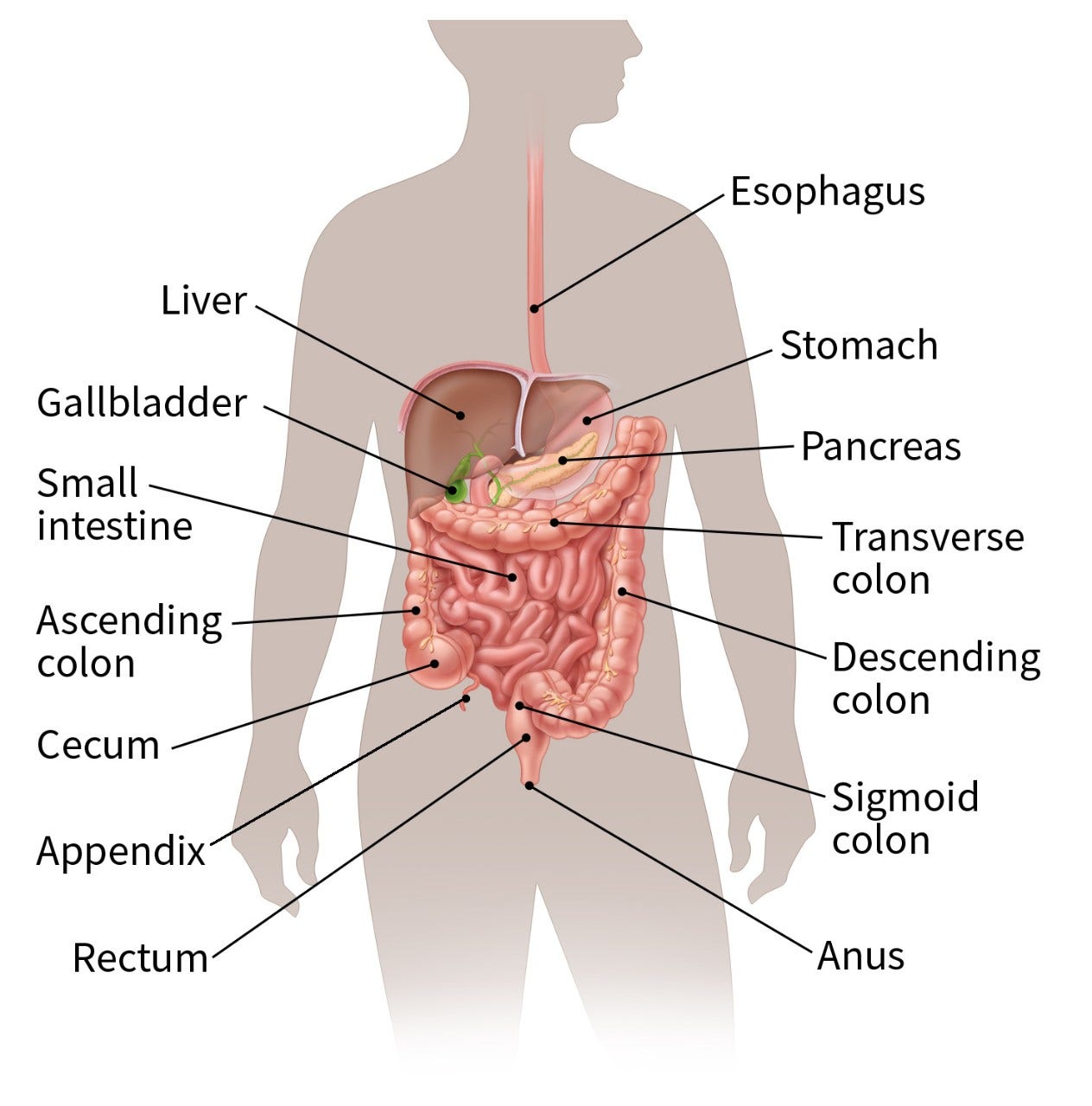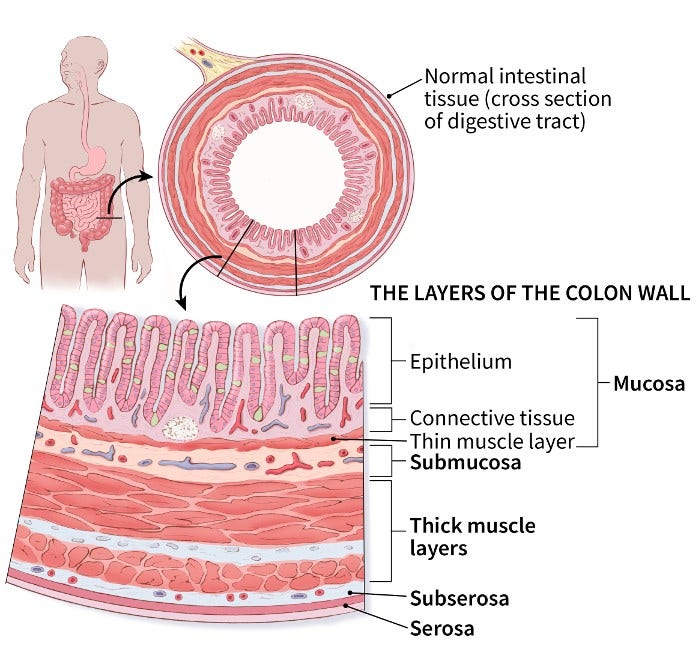Colorectal Cancer
To understand colorectal cancer, it helps to know about the normal structure and function of the colon and rectum.
The colon and rectum make up the large intestine (or large bowel), which is part of the digestive system, also called the gastrointestinal (GI) system (see illustration below).
Most of the large intestine is made up of the colon, a muscular tube about 5 feet (1.5 meters) long. The parts of the colon are named by which way the food is traveling through them.
- The first section is called the ascending colon. It starts with a pouch called the cecum, where undigested food comes in from the small intestine. It continues upward on the right side of the abdomen (belly).
- The second section is called the transverse colon. It goes across the body from the right to the left side.
- The third section is called the descending colon because it descends (travels down) on the left side.
- The fourth section is called the sigmoid colon because of its “S” shape. The sigmoid colon joins the rectum, which then connects to the anus.
The ascending and transverse sections together are called the proximal colon. The descending and sigmoid colon are called the distal colon.

Explore our 3D interactive tour of the digestive system.
How do the colon and rectum work?
The colon absorbs water and salt from the remaining food matter after it goes through the small intestine (small bowel). The waste matter that’s left after going through the colon goes into the rectum, the final 6 inches (15cm) of the digestive system. It’s stored there until it passes through the anus. Ring-shaped muscles (also called sphincters) around the anus keep stool from coming out until they relax during a bowel movement.
How does colorectal cancer start?
Polyps in the colon or rectum
Most colorectal cancers start as a growth on the inner lining of the colon or rectum. These growths are called polyps.
Polyps are quite common, especially as you get older. Most polyps are benign, or noncancerous. Some types of polyps can change into cancer over time (usually over many years). The chance of a polyp turning into cancer depends on the type of polyp it is. There are different types of polyps.
- Adenomatous polyps (adenomas): These polyps sometimes change into cancer. Because of this, adenomas are called a precancerous condition. The 3 types of adenomas are tubular, villous, and tubulovillous. Tubular adenomas are the most common type of adenomatous polyps. Villous adenomas are the least common type of adenomatous polyps, but are more likely to change into cancer.
- Hyperplastic polyps and inflammatory polyps: These polyps are more common, but in general they are not precancerous. Some people with large (more than 1cm) hyperplastic polyps might need colorectal cancer screening with colonoscopy more often.
- Sessile serrated polyps (SSP) and traditional serrated adenomas (TSA): These polyps are often treated like adenomas because they have a higher risk of changing into cancer.
Other factors that can make a polyp more likely to contain cancer or increase someone’s risk of developing colorectal cancer include:
- Size: If a polyp larger than 1 cm
- Number: If more than 3 polyps are found
- Histology: If dysplasia is seen in the polyp. Dysplasia means that the cells look abnormal, but they haven’t yet become cancer.
For more details on the types of polyps and conditions that can lead to colorectal cancer, see Your Colon or Rectal Pathology Report: Polyps.
How colorectal cancer spreads
If cancer forms in a polyp, it can grow into the wall of the colon or rectum over time. The wall of the colon and rectum is made up of many layers. Colorectal cancer starts in the innermost layer (the mucosa) and can grow outward through some or all of the other layers (see picture below).
When cancer cells are in the wall, they can then grow into blood vessels or lymph vessels (tiny channels that carry away waste and fluid). From there, they can travel to nearby lymph nodes or to distant parts of the body.
The stage (extent of spread) of a colorectal cancer depends on how deeply it grows into the wall and if it has spread outside the colon or rectum. For more on staging, see Colorectal Cancer Stages.

Types of cancer in the colon and rectum
Most colorectal cancers are adenocarcinomas. These cancers start in cells that make mucus to lubricate the inside of the colon and rectum. When doctors talk about colorectal cancer, they’re almost always talking about this type. Some subtypes of adenocarcinoma, such as signet ring and mucinous, may have a worse prognosis (outlook) than other subtypes of adenocarcinoma.
Other, much less common types of tumors can also start in the colon and rectum. These include:
- Carcinoid tumors. These start from special hormone-making cells in the intestine. See Gastrointestinal Carcinoid Tumors.
- Gastrointestinal stromal tumors (GISTs) start from nerve cells in the wall of the gastrointestinal tract. Some are benign (not cancer). These tumors are most commonly found in the stomach and small intestine. They are not commonly found in the colon or rectum. See Gastrointestinal Stromal Tumor (GIST).
- Lymphomas are cancers of immune system cells. They mostly start in lymph nodes, but they can also start in the colon, rectum, or other organs. Information on lymphomas of the digestive system can be found in Non-Hodgkin Lymphoma.
- Sarcomas can start in blood vessels, muscle layers, or other connective tissues in the wall of the colon and rectum. Sarcomas of the colon or rectum are rare. See Soft Tissue Sarcoma.
Copyright © 2025 Latin X Cancer Alliance Inc - All Rights Reserved.
Latin X Cancer Alliance is a Registered Non Profit, 501c3
